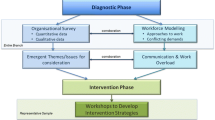Abstract
This study focuses on the operative level within military staffs jointly leading units in combat, whose decisions of necessity are dynamic. The aim of the present study was to describe the conditions constituting so-called good dynamic decision-making in real situation using a descriptive model. What factors are weaknesses in decision-making? Can the weaknesses be identified and then bring ideas to decision support needed and also what training might be required? For the purpose of the study, 214 participants have completed a questionnaire. Factor analysis and structural equation modelling (LISREL 8) are used as methods for analysing data. The results show that it is possible to describe dynamic decision-making using a structural equation modelling model. The main implication is that continued studies of dynamic decision-making can be carried out with a type of descriptive model.

Similar content being viewed by others
Notes
In a strictly confirmatory situation, Jöreskog and Sörbom (1993) advocate a less strict test, the root mean square error of approximation (RMSEA) that, above sampling error, also for a model error of the same magnitude, as well as taking sample size into consideration. A RMSEA below 0.05 indicates a model with a close fit, a fair fit is indicated with a RMSEA below 0.08, and a RMSEA above 0.10 indicates a poor fit.
References
Brehmer B (1992) Dynamic decision-making: human control of complex systems. Acta Psychol 81:211–241
Brehmer B (2005) The dynamic OODA loop: amalgamating Boyd′s OODA loop and the cybernetic approach to command and control. Paper presented at 10th CCRTS, McLean, VA
Brehmer B, Allard R (1991) Real time, dynamic decision-making. The effects of complexity and feedback delays. In: Rasmussen J, Brehmer B, Leplat J (eds) Distributed decision-making: cognitive models of cooperative work. Wiley, New York
Dörner D (1996) The logic of failure. Metropolitan Books, New York
Dörner D, Wearing A (1995) Complex problem-solving: towards a (computer simulated) theory. In: Frensch PA, Funke J (eds) Complex problem-solving: the European perspective, Hillsdale, NJ, Lawrence Erlbaum Associates, pp 65–99
Hair JF, Black WC, Babin BJ, Anderson RE (2010) Multivariate data analysis. A global perspective. Pearson Education, Inc., Upper Saddle River, NJ
Hörberg B (1993) Träning av bataljonchefens uppgift–att leda pansarstrid. FOA PM 55:180
Hörberg B (1994) Faktorer som påverkar en bataljonchefs beslut. PM 55:181
Jöreskog K, Sörbom D (1993) LISREL8®: structural equation modelling with the SIMPLIS command language. Scientific Software International, Inc, Chicago
Klein G (1993) A recognition-primed decision (RPD) model of rapid decision-making. In: Klein GA, Orasanu J, Calderwood R, Zsambok CE (eds) Decision-making in action: models and methods. Ablex Publishing, New Jersey, pp 138–148
Kylesten B (2007) A frame of reference for describing dynamic decision-making in a command training facility. Article manuscript
Kylesten B, Nählinder S (2011) The effect of decision-making training. Results from a command and control training facility. Cognition, technology and work. London, Springer (Forthcoming)
Schmitt J, Klein G (1999) A recognitional planning model. proceedings of the 1999 command and control research and technology symposium. Naval War College, Newport, Rhode Island
Thunholm P (2003) Military decision-making and planning: Towards a new prescriptive model. Department of Psychology, Stockholm University, Edsbruk, Akademitryck
Acknowledgments
This work was supported by a FOI research project, which was funded by the R&D program of the Swedish Armed Forces.
Author information
Authors and Affiliations
Corresponding author
Appendix: Factors measured with questionnaire
Appendix: Factors measured with questionnaire

Rights and permissions
About this article
Cite this article
Kylesten, B. Dynamic decision-making on an operative level: a model including preconditions and working method. Cogn Tech Work 15, 197–205 (2013). https://doi.org/10.1007/s10111-012-0221-z
Received:
Accepted:
Published:
Issue Date:
DOI: https://doi.org/10.1007/s10111-012-0221-z




